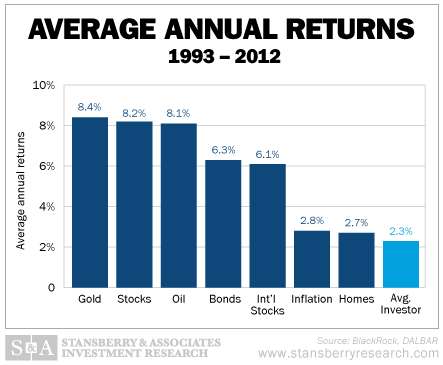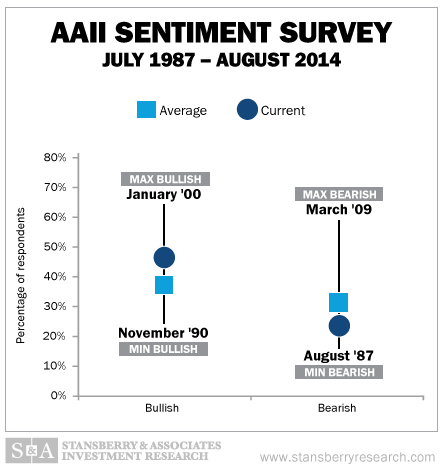Meb started with the bad news: "You're a terrible investor."
Today, I'm sharing an important idea discussed at the latest Stansberry Conference Series event in L.A. It's not a stock pick... But it could be a thousand times more valuable than any one trading idea.
It came from Meb Faber, whom Porter introduced as "one of the most innovative guys in all of finance." Meb is a longtime friend of S&A and is always one of the smartest guys in the room.
One of the first slides Meb shared with the audience in L.A. was a version of the chart below. It shows the average annual returns of a variety of assets over the past 20 years or so...
Way on the losing end, past even inflation, you'll find the average investor's returns.

Part of the problem, Meb explained, is fees - commissions, loads, and other brokerage charges. But the much, much bigger issue is that individual investors buy and sell at exactly the wrong moment.
"They're terrible at timing," Meb said. "And when I say 'they,' I mean, in many cases, you." The next chart proves his point.
The American Association of Individual Investors (AAII) publishes a weekly survey of its members - mostly "mom and pop" investors. Every week, it asks them a simple question: "Are you bullish, neutral, or bearish on the stock market over the next six months?"
Below, you'll find the range of weekly counts of bullish and bearish investors since mid-1987.
The highest bullish reading ever was January 2000 - just before the dot-com bubble burst. The highest bearish reading ever was March 2009, the exact bottom of the recent crash... and a fantastic time to buy stocks.

As Meb explained, "This is a great quantitative illustration of how bad people are with their emotions."
When you're reading bearish headlines, when you're losing money, when your friends and neighbors are frightened... it's hard to be bullish. On the other hand, when the news is rosy, when you're doing well, when your friends and neighbors are bragging about the money they're making... it's hard to be bearish. Most folks find it much more comfortable to move with the crowd.
And while the audience in L.A. - and readers of Growth Stock Wire - might be more sophisticated traders than most... Meb didn't let them off the hook.
"Most of you - most of us - think we're better looking than average, smarter than average," he said. "But the math doesn't work out."
So what can you do to be better than average... to make sure the math does work out for you?
Two things...
The first is to have a plan. As Meb said, "No football coach says, 'Wow, I don't know what to do when it's third and two... Let's figure it out once we get to the line of scrimmage.'"
In my DailyWealth Trader advisory, we start every position with a clear plan. When we use a trailing stop, for example, we know exactly what to do if the asset goes up (sit tight) or if the asset falls (cut our losses).
If you stick with this discipline, you'll exit a trade well before most folks give up and the asset bottoms. And you'll never have to wonder what to do at "third and two."
The second thing you can do to combat your natural tendency to follow the herd is to make sure you know exactly what the herd is doing.
The best way to "map" the crowd is with sentiment indicators (like the AAII sentiment survey and cocktail party chatter). These tools are most useful when the herd is either very bullish or very bearish. When you see one of sentiment indicators signal an "extreme," it's important to either protect yourself from the inevitable reversal... or move in the other direction.
As you can see in the AAII chart above, sentiment now is a little more bullish and a little less bearish than average. (The two percentages don't add up to 100% because some folks are neutral.) But neither reading is at an extreme. That supports the idea that this bull market may have farther to run.
Meb noted that in the market, we're often our own "worst enemies." Your emotions prompt you to buy high and sell low. But you don't have to listen. Once you understand that, you can become a much, much better investor.
No comments:
Post a Comment